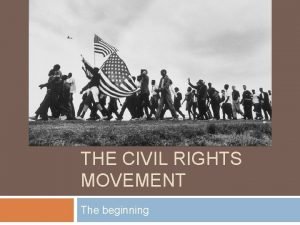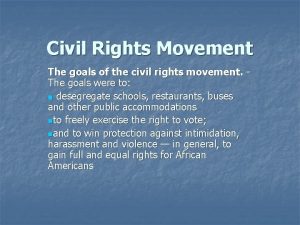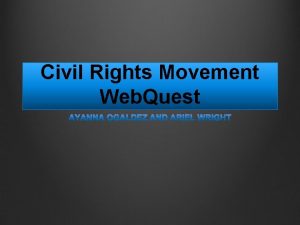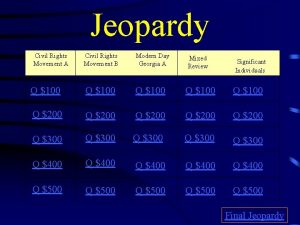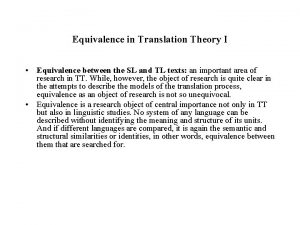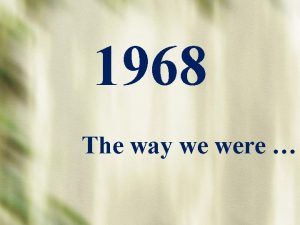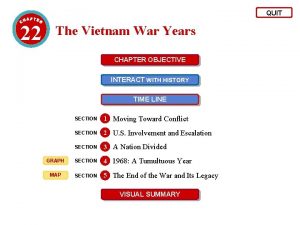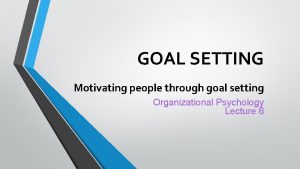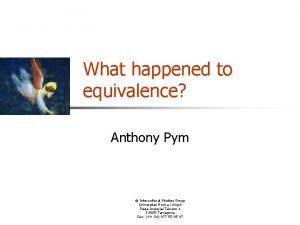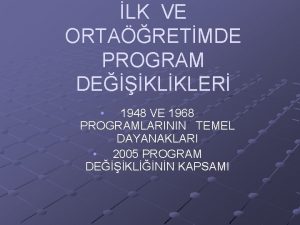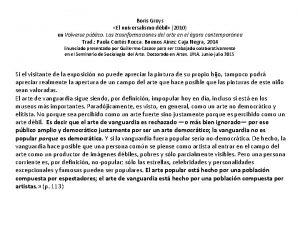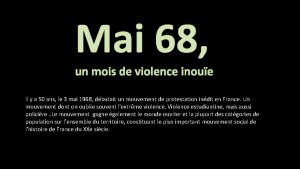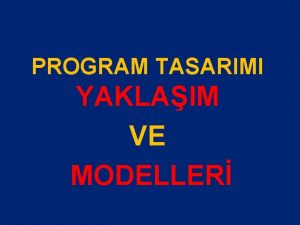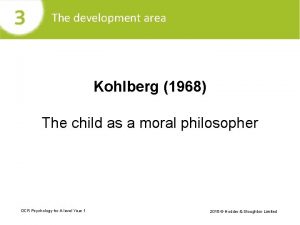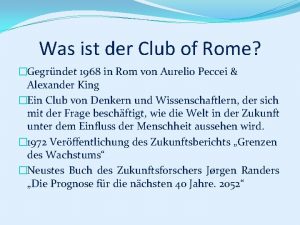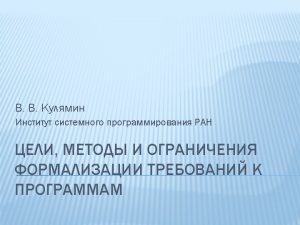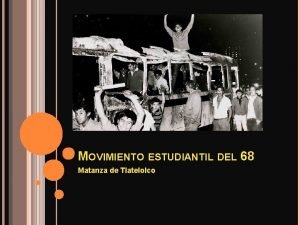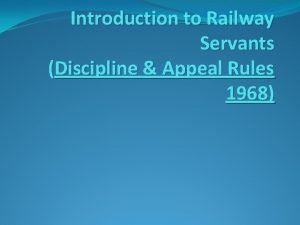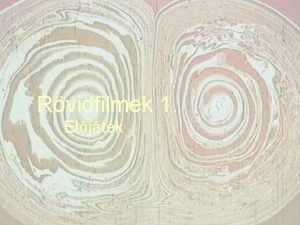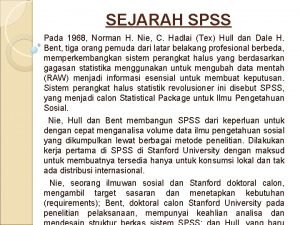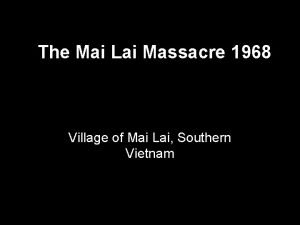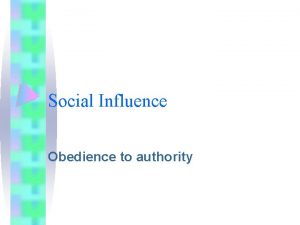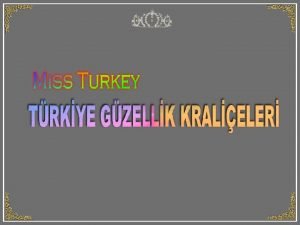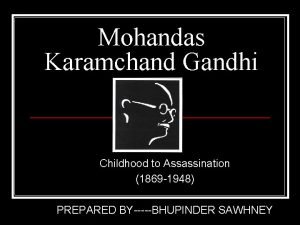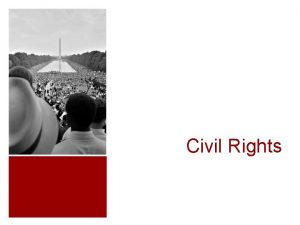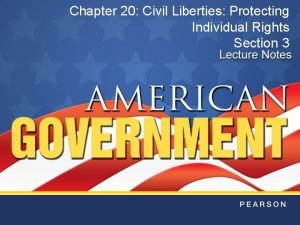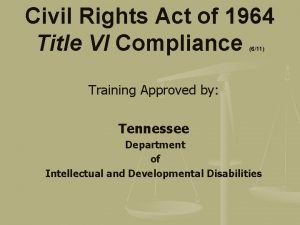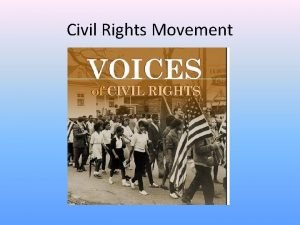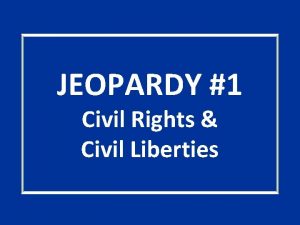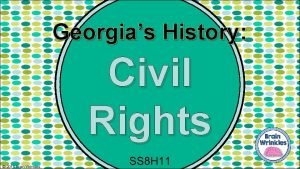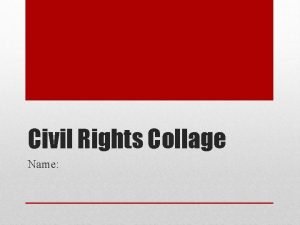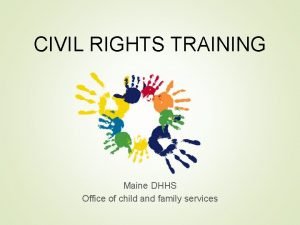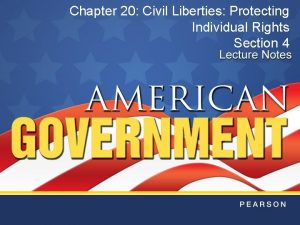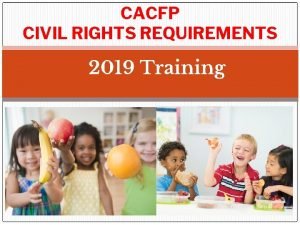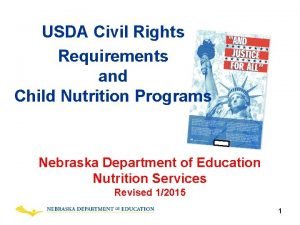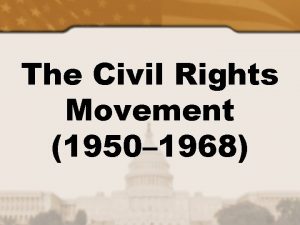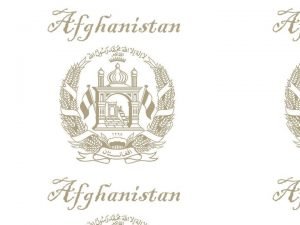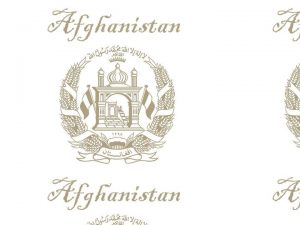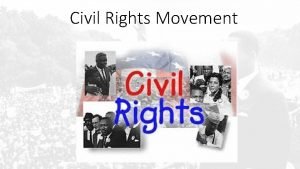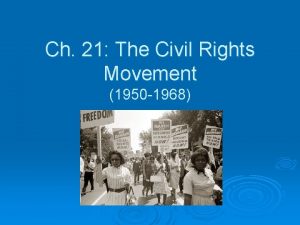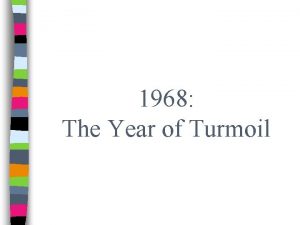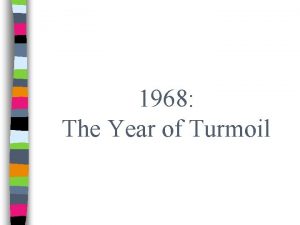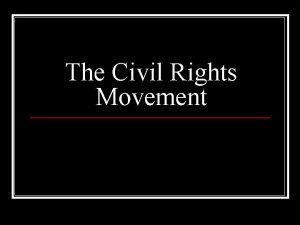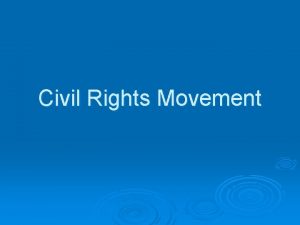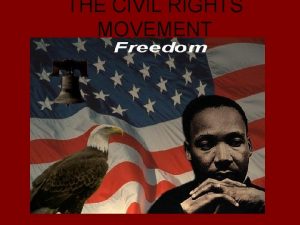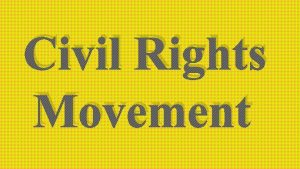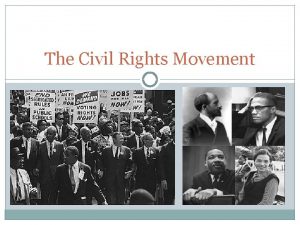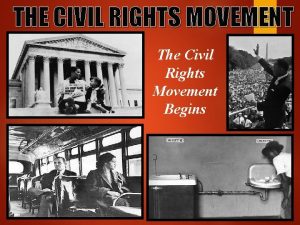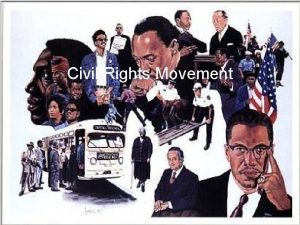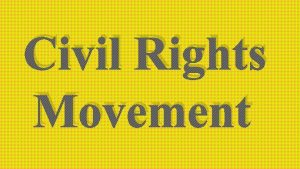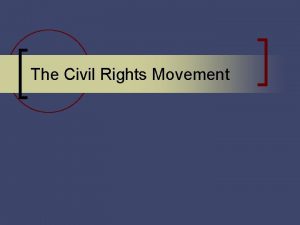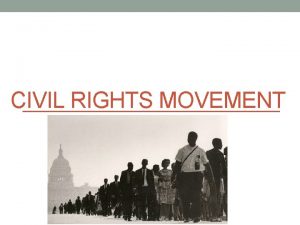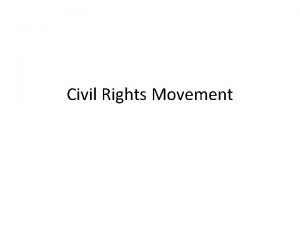The Civil Rights Movement 1950 1968 Civil Rights

















































- Slides: 49

The Civil Rights Movement 1950 -1968 Civil Rights Act of 1875

Impetus for change • African Americans left the south and became more of an economical and political force • Great Migration during WWI and WWII • Jobs and voters to support the New Deal • Creation of the NAACP (National Association for the Advancement of Colored People)

Brown vs. Board of Education, 1954 • 8 yr old Linda Brown, and many other black children in the nation, lived very close to an all white school but was forced to walk past it everyday to attend an all black school • Thurgood Marshall argued before the Supreme Court that this was a violation of Linda’s 14 th Amendment right (equal protection under the law) • The court declared unanimously that the “separate but equal” was unconstitutional and school boards should move to desegregate “with all deliberate speed. ” Every day Linda and her sister, Terry Lynn, had to walk through the Rock Island Railroad Switchyard to get to the bus stop for the ride to the all-black Monroe School.

• The Supreme Court specifically cited Kenneth Bancroft Clark and his wife, Mamie Phipps Clark's 1950 paper on the doll test in the Brown decision. • used four plastic, diaper-clad dolls, identical except for color • showed the dolls to black children ages 3 -7 • almost all of the children easily identified the race of the dolls • when asked which they preferred, the majority selected the white doll • also gave the children outline drawings of a boy and girl and asked them to color the figures the same color as themselves • many of the children with dark complexions colored the figures with a white or yellow crayon • the Clarks concluded that "prejudice, discrimination, and segregation" caused black children to develop a sense of inferiority and self-hatred Doll Test

The ruling • The Supreme Court ruling in the case of Brown v. Board of Education was unanimous — the doctrine of “separate-butequal” was inherently unconstitutional. • Delivering the court’s opinion, Chief Justice Earl Warren asserted that “segregated schools are not equal and cannot be made equal, and hence they are deprived of the equal protection of the laws. ”

Thurgood Marshall • One of Marshall's more important legal cases was his arguing and winning the landmark case Brown v Board of Education before the U. S. Supreme Court in 1954 • Thurgood Marshall became the first black justice on the U. S. Supreme Court in 1967;

Emmett Till • was an African American boy from Chicago, Illinois, who was murdered at the age of 14 in Money, Mississippi, after reportedly whistling at a white woman • The murder of Emmett Till was one of the leading events that motivated the American Civil Rights Movement • The main suspects were acquitted, but later admitted to the murder.

The Montgomery Bus Boycott • Rosa Parks did not refuse to sit in the “colored section”; she refused to give up her seat in the “colored section” to a white man • Jo Ann Robinson helped to quickly organize the Montgomery bus boycott • MIA (Montgomery Improvement Association) was organized and the 26 year old minister was asked to be the spokesperson, Dr. Martin Luther King, Jr.


• It wasn’t enough to boycott for a couple of days • The boycott had to financially hurt the City of Montgomery in order to make a difference • Over the next year, 50, 000 African Americans refused to use the public transportation system • People from all around the country donated money, cars, etc. to help the people of Montgomery continue the boycott • In 1956, the Supreme Court ruled that bus segregation was UNCONSTITUTIONAL

Trouble in Little Rock, Arkansas • Governor Orval Faubus ordered the National Guard to keep out the 9 black children that were to enroll in the school • President Eisenhower took over the National Guard and ordered them to protect the 9 children as they enrolled and attended the school • This protection included watching over them during their classes

Little Rock Nine

The 9 were escorted to school that day but Elizabeth did not have a phone. She was not contacted and made it to school by public transportation. Her experience was unbelievable.

The REST of the Little Rock Story • subjected to a year of physical and verbal abuse (spitting on them, calling them names) by many of the white students • Melba Pattillo had acid thrown into her eyes. • Minnijean Brown was also taunted by members of a group of white, male students in December 1957 in the school cafeteria during lunch. She dropped her lunch – a bowl of chili – onto the boys and was suspended for six days. • Two months later, Minnijean Brown was suspended for the rest of the school year. She transferred to New Lincoln High School in New York City. • white students were only punished when their offense was "both egregious and witnessed by an adult".

Hispanics and Native Americans were struggling for equality • LULAC: League of United Latin American Citizens • Fought for equal education of Hispanics, register more Hispanic voters and get them elected. • Native Americans were fighting to stop assimilation and the ability to keep their ways of life • Fought for autonomy-the right to govern themselves

Leaders and Strategies of the Civil Rights • NAACP played an important role in fighting unconstitutional legislation that denied the rights of African Americans (use the court system) • National Urban League helped minorities when they moved into major cities. They fought for them on the job and when trying to secure housing • CORE created in the 40 s, started using passive means to fight segregation. This organization’s popularity will grow throughout the 50 s

• SCLC: a nonviolent organization led by MLK • The Southern Christian Leadership Conference • formed in 1957 • two objectives: use nonviolent protest as a method of resistance to discrimination and to appeal to the moral conscience of Americans

Martin Luther King, Jr. • King followed in the steps of Mohandas Gandhi, the leader that fought for India’s independence from Great Britain • Gandhi advocated PEACEFUL disobedience

SNCC- Student Non-violent Coordinating Committee (SNICK) • SNCC initially started so that students could support the protest of organizations such as SCLC • wanted more than a gradual movement away from segregation • were much more aggressive in their approach • Members like Robert Moses, a Harvard graduate, led the young students • helped organize volunteers to help blacks register to vote.

• “We reserve the right to serve the public as we see fit” • Signs posted in Woolsworth and Kress stores as a result of young African Americans organizing sit ins in the restaurant part of the stores • The students always remained nonviolent and respectful. • Some "Do's" and "Don'ts" during sit-ins: • Do show yourself friendly on the counter at all times. Do sit straight and always face the counter. Don't strike back, or curse back if attacked. Don't laugh out. Don't hold conversations. Don't block entrances. • By August 1961, the sit ins had attracted over 70, 000 participants and generated over 3, 000 arrests.


The Freedom Rides • volunteers agreed to ride from Washington, D. C. to Jackson, MS to establish desegregation on interstate buses • In Anniston, AL, a mob of whites slashed the tires of the bus, threw a firebomb into the bus, and then beat the Freedom Riders when they exited the bus



• The Ku Klux Klan hoped that the violence against these freedom riders would stop others from taking part in the freedom rides, but in the next six months over a thousand people took part in the freedom rides, with Byron White, a man sent by the president, and 500 federal marshals for protection. • Robert Kennedy petitioned the Interstate Commerce Commission (ICC) to draft regulations to end racial segregation in bus terminals. The ICC was reluctant but on September 22, 1961 it issued the necessary orders and it went into effect on November 1 st.

Ole Miss look who’s coming to class!! • James Meredith wanted to attend all white Ole Miss • The Supreme Court agreed that he should be able to attend • Gov. Barnett personally appeared at Ole Miss and said he could not attend • Kennedy sent to National Guard to insure that he could enroll in the all white university

Birmingham in the Spotlight • Rev. Shuttlesworth asked Rev. Martin Luther King to help Birmingham fight segregation • During a peaceful march MLK and others were jailed as a result of Birmingham Police Commissioner Bull O Connor’s determination to stop desegregation Birmingham became known as “the most segregated city in the South”.

• When the demonstrations started again, MLK made the decision to allow the youth to participate (Children’s March) • More than 900 young people were jailed • The nation watched these attacks • It is said that Bull Connor did a great deal for the Civil Rights Movement--- WHY? ?

• • Kennedy stands and Medger Evers falls President Kennedy decided to take a firm stand for civil rights after the violence in Birmingham He broadcast a speech over the radio about the responsibility of America to actually become the “land of the free” That night Medger Evers, an active member of the NAACP, was shot in his driveway with his family right inside the house. This was 1963. It was 1994 before Byron de la Beckwith was found guilty of the murder (Ghost of Mississippi)

March on Washington • Kennedy become more determined to pass a useful Civil Rights Act • A. Philip Randolph organized a March on Washington in August of 1963 to draw more attention to the Civil Rights Movement • Over 200, 000 people attended the event • Martin Luther King delivered his famous “I Have a Dream” speech

24 th Amendment • Outlawed poll tax

Civil Rights Act of 1964 • In November of 1963, President Kennedy was assassinated and the Civil Rights Act had not yet passed • Lyndon B. Johnson, the new President, was determined to see Civil Rights Act passed • Congress attempted to stop the vote on the legislation by continuing the debate on the act so long that a vote could not take place (filibuster) • This plan did not work and the Civil Rights Act of 1964 passed

Civil Rights Act of 1964 • Different registration standards for black and white voters was banned • No discrimination in public accommodations (gas stations, theaters, etc) • Federal funding could be withheld from public or private programs that practiced discrimination • Discrimination was banned in the workplace

Getting African Americans Registered to vote • Freedom Summer was organized by mostly college students. Robert Moses was very active in the fight to register African Americans to vote. • Although black men won the right to vote in 1870, thanks to the 15 th Amendment, for the next 100 years many were unable to exercise that right. • What methods were used to stop the African American from voting?

Freedom Summer, cont. • The focus of Freedom Summer was on Mississippi • In 1962 only 6. 7 percent of African Americans in the state were registered to vote, the lowest percentage in the country. • This too resulted in violence • Three young civil rights workers James Chaney, Andrew Goodman, and Michael Schwerner were found buried in a earthen dam

Fannie Lou Hamer • Some newly registered voters organized the Mississippi Freedom Democratic Party (MFDP) • Fannie Lou Hamer was one of the organizers • At 44 years old, Fannie was surprised to learn that African-Americans actually had a constitutional right to vote.

Selma March • Selma refused to allow African Americans to register to vote • A protest march was organized from Selma to Montgomery • MLK led the march that is still celebrated annually today

Voting Rights Act of 1965 • This legislation officially outlaws literacy test and other barriers • In 1965, more than 400, 000 African Americans registered to vote in the South • The Twenty-fourth Amendment then outlawed the poll tax that was being used to stop voting • Allowed federal officials to register voters

The Movement Takes a New Turn

Malcolm X • Joined Nation of Islam while in jail • In favor of black separatism and self-help • Believed in black nationalism-a belief in a separate identity and racial unity of the African-American community • After trip to Mecca, earned enemies of some Muslims due to new willingness to work w/ other races

Malcolm X • Shot to death in February 1965 • 3 members of Nation of Islam charged

Stokely Carmichael • New leader of SNCC • Took a more militant/ radical turn • Called on SNCC workers to carry guns in self-defense • “We shall overrun. ” • Black Power

Black Panthers • Formed by Bobby Seale and Huey Newton • “Power flows from the barrel of a gun. ” Mao Zedong—repeated by Newton • “Black is beautiful. ” • Split with NAACP and other non-violent groups

• • • Rioting Erupts August 11, 1965, in Watts, a neighborhood in Los Angeles, when Lee Minikus, a California Highway Patrol motorcycle officer, pulled over Marquette Frye, who Minikus believed was intoxicated Frye failed to pass sobriety tests and was arrested Minikus refused to let Frye's brother drive the car home and radioed for it to be impounded events escalated, a crowd of onlookers steadily grew from dozens to hundreds mob became violent, throwing rocks and other objects while shouting at the police officers. A struggle ensued shortly resulting in the arrest of Marquette and Ronald Frye, as well as their mother.

The real story • Frye and Minikus had been joking with one another until Frye’s mother arrived • Rumors spread through crowd that police were brutalizing Frye’s mother and pregnant girlfriend • Riots erupt, last 6 days, 34 people died, 1000 wounded, and an estimated $50 - $100 million in property damage • Unemployment, poverty, poor housing, distrust of the brutal police force, and heat played part in riots

20, 000 national guard called in

Kerner Commission-1968 • Commissioned by LBJ in 1967 to determine the cause of the riots in Watts • "What happened? Why did it happen? What can be done to prevent it happening again and again? “ • report became an instant best-seller, and over two million Americans bought copies of the 426 -page document • Its finding was that the riots resulted from black frustration at lack of economic opportunity • The report's most infamous passage warned, "Our nation is moving toward two societies, one black, one white—-separate and unequal. "

1968 -A year of Tragedy • MLK assassinated in Memphis, TN by James Earl Ray; conspiracy theories flourished • Had begun new campaign to combat economic injustice; planned on leading Poor People’s March on Washington • Rioting erupted across the U. S.

RFK assassinated • LBJ declared that he would not run for reelection in 1968 • RFK campaigned against Mc. Carthy for the Democratic nomination • Won California primary • Assassinated after giving victory speech at LA hotel by Sirhan
 Civil rights and civil liberties webquest
Civil rights and civil liberties webquest The civil rights movement
The civil rights movement Civil rights movement goal
Civil rights movement goal Civil rights movement essential questions
Civil rights movement essential questions Civil rights movement vocabulary
Civil rights movement vocabulary Rosa parks mother
Rosa parks mother Civil rights movement webquest
Civil rights movement webquest Civil rights movement jeopardy
Civil rights movement jeopardy Equivalence theory in translation
Equivalence theory in translation Cost of living 1968
Cost of living 1968 Chapter 22 section 4 1968: a tumultuous year answer key
Chapter 22 section 4 1968: a tumultuous year answer key Edwin locke goal setting theory 1968
Edwin locke goal setting theory 1968 Otto kade 1968
Otto kade 1968 1968 hayat bilgisi programı
1968 hayat bilgisi programı Boris groys volverse publico
Boris groys volverse publico Atkinson & shiffrin 1968
Atkinson & shiffrin 1968 Vietnam 1968
Vietnam 1968 Paris mai 1968
Paris mai 1968 1948 ilkokul programı
1948 ilkokul programı Tc 24 juin 1968 société distilleries bretonnes
Tc 24 juin 1968 société distilleries bretonnes First filipino expert on fingerprinting
First filipino expert on fingerprinting Kohlberg 1968
Kohlberg 1968 We want you
We want you Software crisis 1968
Software crisis 1968 1966 1967 1968 1969 1970 1971 1972 1973 1974 1975
1966 1967 1968 1969 1970 1971 1972 1973 1974 1975 Introduccion de la matanza de tlatelolco
Introduccion de la matanza de tlatelolco Railway discipline and appeal rules book
Railway discipline and appeal rules book Spaulding 1968
Spaulding 1968 Mélyvíz 1970
Mélyvíz 1970 Spss 1968
Spss 1968 Mai lai massacre 1968
Mai lai massacre 1968 Brom im alltag
Brom im alltag Orne and holland
Orne and holland Türkiye güzeli nazlı deniz kuruoğlu
Türkiye güzeli nazlı deniz kuruoğlu Program of civil disobedience movement
Program of civil disobedience movement Civil right def
Civil right def Movement area
Movement area Axial dance definition
Axial dance definition Chapter 20 civil liberties protecting individual rights
Chapter 20 civil liberties protecting individual rights Title vi of the civil rights act of 1964
Title vi of the civil rights act of 1964 Civil rights movment
Civil rights movment Chapter 20 civil liberties protecting individual rights
Chapter 20 civil liberties protecting individual rights Levittown apush
Levittown apush Civil rights jeopardy
Civil rights jeopardy Civil rights cloze notes 1
Civil rights cloze notes 1 Civil rights leaders collage
Civil rights leaders collage Civil rights training certificate
Civil rights training certificate Chapter 20 civil liberties protecting individual rights
Chapter 20 civil liberties protecting individual rights Cacfp civil rights
Cacfp civil rights Civil rights in child nutrition programs
Civil rights in child nutrition programs

